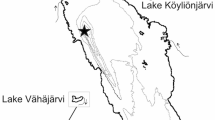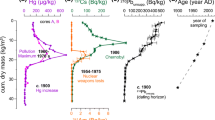Abstract
Historical phosphorus (P) dynamics were studied using sediment cores from three oligotrophic, acidic lakes in Maine, USA. Long-term oligotrophy of these lakes is consistent with high sediment aluminum (as Al(OH)3) concentrations, as Al inhibits internal P loading, even under reducing conditions. The role of microbially-mediated reactions in controlling redox conditions was evaluated by estimating microbial biomass and relative abundance of specific functional groups. Sediments were fractionated using a sequential chemical extraction technique and all lakes met criteria for P retention based on threshold sediment concentrations of Al, Fe, and P fractions as determined by (Kopáček et al. (2005) Limnol Oceanogr 52: 1147–1155). Sediment NaOH-extractable molybdate-reactive P (rP) and non-reactive P (nrP) represent P associated with non-reducible phases, and organic matter-related P, respectively. Total P (TP) does not decrease with sediment depth, as is typical of eutrophic lake sediments; however, nrP/TP decreases and rP/TP increases for all three lakes, indicating nrP mineralization without any significant upward diffusion and release into the hypolimnion; i.e. diagenesis of P is conservative within the sediment. Two diagenetic models were developed based on nrP and rP concentrations as a function of sediment age. The first model assumes a first-order decay of nrP, the rate coefficient being a function of time, and represents irreversible nrP mineralization, where the produced PO4 is permanently sequestered by the sediment. The second model assumes a first-order reversible transformation between nrP and rP, representing biotic mineralization of organic P followed by incorporation of inorganic P into microbial biomass. Both models reflect preservation of TP with no loss to overlying water. The rate coefficients give us insight into qualities of the sediment that have affected mineralization and sequestration of phosphorus throughout the 210Pb-dateable history of each lake. Similar models could be constructed for other lakes to help reconstruct their trophic histories. Paleolimnological reconstruction of the sediment P record in oligotrophic lakes shows mineralization of nrP to rP, but unlike the case in eutrophic lake sediments, sediment TP is preserved in these sediments.






Similar content being viewed by others
References
Ahlgren J, Tranvik L, Gogoll A, Waldeback M, Markides K, Rydin E (2005) Sediment depth attenuation of biogenic phosphorus compounds measured by P-31 NMR. Environ Sci Technol 39:867–872
Ahlgren J, Reitzel K, Tranvik L, Gogoll A, Rydin E (2006) Degradation of organic phosphorus compounds in anoxic Baltic sea sediments: a P-31 nuclear magnetic resonance study. Limnol Oceanogr 51:2341–2348
Amirbahman A, Pearce AR, Bouchard RJ, Norton SA, Kahl JS (2003) Relationship between hypolimnetic phosphorus and iron release from eleven lakes in Maine, USA. Biogeochemistry 65:369–385
Anderson RT, Rooney-Varga JN, Gaw CV, Lovley DR (1998) Anaerobic benzene oxidation in the Fe(III) reduction zone of petroleum contaminated aquifers. Environ Sci Technol 32:1222–1229
Appleby PG, Oldfield F (1978) The calculation of 210Pb dates assuming a constant rate of supply of unsupported 210Pb to the sediment. Catena 5:1–8
Caraco NF, Cole JJ, Likens GE (1993) Sulfate control of phosphorus availability in lakes–a test and reevaluation of Hasler and Einsele model. Hydrobiologia 253:275–280
Carignan R, Lean DRS (1991) Regeneration of dissolved substances in a seasonally anoxic lake–the relative importance of processes occurring in the water column and in the sediments. Limnol Oceanogr 36:683–707
Davis RB, Doyle RW (1969) A piston corer for upper sediment in lakes. Limnol Oceanogr 14:643–648
Davis RB, Anderson DS, Norton SA, Whiting MC (1994) Acidity of twelve northern New England (U.S.A.) lakes in recent centuries. J Paleolimn 12:103–154
DeVicente I, Huang P, Andersen FO, Jensen HS (2008) Phosphate adsorption by fresh and aged aluminum hydroxide. Consequences for lake restoration. Environ Sci Technol 42:6650–6655
Einsele W (1936) Über die Beziehungen des Eisenkreislaufs zum Phosphatkreislauf im eutrophen See. Archiv für Hydrobiologie 29:664–686
Furumai H, Ohgaki S (1982) Fractional composition of phosphorus forms in sediments related to release. Water Sci Technol 14:215–226
Gächter R, Meyer JS (1993) The role of microorganisms in mobilization and fixation of phosphorus in sediments. Hydrobiologia 253:103–121
Gächter R, Meyer JS, Mares A (1988) Contribution of bacteria to release and fixation of phosphorus in lake sediments. Limnol Oceanogr 33:1542–1558
Geets J, Borrernans B, Diels L, Springael D, Vangronsveld J, van der Lelie D, Vanbroekhoven K (2006) DsrB gene-based DGGE for community and diversity surveys of sulfate-reducing bacteria. J Microbiol Methods 66:194–205
Goedkoop W, Pettersson K (2000) Seasonal changes in sediment phosphorus forms in relation to sedimentation and benthic bacterial biomass in Lake Erken. Hydrobiologia 431:41–50
Golterman H, Paing J, Serrano L, Gomez E (1998) Presence of and phosphate release from polyphosphates or phytate phosphate in lake sediments. Hydrobiologia 364:99–104
Hallin S, Lindgren PE (1999) PCR detection of genes encoding nitrile reductase in denitrifying bacteria. Appl Environ Microbiol 65:1652–1657
Hieltjes AHM, Lijklema L (1980) Fractionation of inorganic phosphates in calcareous sediments. J Environ Qual 9:405–407
Holmes DE, Finneran KT, O’Neil RA, Lovley DR (2002) Enrichment of members of the family Geobacteraceae associated with stimulation of dissimilatory metal reduction in uranium-contaminated aquifer sediments. Appl Environ Microbiol 68:2300–2306
Hupfer M, Gächter R (1995) Polyphosphate in lake-sediments–31P NMR-spectroscopy as a tool for its identification. Limnol Oceanogr 40:610–617
Hupfer M, Rube B, Schmieder P (2004) Origin and diagenesis of polyphosphate in lake sediments: a P-31-NMR study. Limnol Oceanogr 49:1–10
Jansson M (1987) Anaerobic dissolution of iron phosphorus complexes in sediment due to the activity of nitrate-reducing bacteria. Microbial Ecol 14:81–89
Kaushal S, Binford MW (1999) Relationship between C:N ratios of lake sediments, organic matter sources, and historical deforestation in Lake Pleasant, Massachusetts, USA. J Paleolimn 22:439–442
Kleeberg A (1997) Interactions between benthic phosphorus release and sulfur cycling in Lake Scharmutzelsee (Germany). Water Air Soil Pollut 99:391–399
Kopáček J, Hejzlar J, Borovec J, Porcal P, Kotorová I (2000) Phosphorus inactivation by aluminum in the water column and sediments: Lowering of in-lake phosphorus availability in an acidified watershed-lake ecosystem. Limnol Oceanogr 45:212–225
Kopáček J, Borovec J, Hejzlar J, Ulrich KU, Norton SA, Amirbahman A (2005) Aluminum control of phosphorus sorption by lake sediments. Environ Sci Technol 39:8784–8789
Kopáček J, Maresova M, Norton SA, Porcal P, Vesely J (2006) Photochemical source of metals for sediments. Environ Sci Technol 40:4455–4459
Kopáček J, Marešová M, Hejzlar J, Norton SA (2007) Natural inactivation of phosphorus by aluminum in pre-industrial lake sediments. Limnol Oceanogr 52:1147–1155
Lake BA, Coolidge KM, Norton SA, Amirbahman A (2007) Factors contributing to the internal loading of phosphorus from anoxic sediments in six Maine, USA, lakes. Sci Total Environ 373:534–541
Luton PE, Wayne JM, Sharp RJ, Riley PW (2002) The mcrA gene as an alternative to 16S rRNA in the phylogenetic analysis of methanogen populations in landfill. Microbiol-(UK) 148:3521–3530
Malmaeus JM, Rydin E (2006) A time-dynamic phosphorus model for the profundal sediments of Lake Erken, Sweden. Aquatic Sci 68:16–27
Mitchell A, Baldwin DS (1998) Effects of desiccation/oxidation on the potential for bacterially mediated P release from sediments. Limnol Oceanogr 43:481–487
Mortimer CH (1941) The exchange of dissolved substances between mud and water in lakes. J Ecol 29:280–329
Murphy J, Riley JP (1962) A modified single solution method for determination of phosphate in natural waters. Anal Chim Acta 27:31–36
Navrátil T, Rohovec J, Amirbahman A, Norton SA, Fernandez IJ (2009) Amorphous aluminum hydroxide control on sulfate and phosphate in sediment-solution systems. Water, Air, and Soil Poll 201:87–98
Nealson KH (1997) Sediment bacteria: who’s there, what are they doing, and what’s new? Ann Rev Earth Planetary Sci 25:403–434
Nurnberg GK (1996) Phosphorus budgets and stoichiometry during the open-water season in two unmanipulated lakes in the experimental Lakes Area, northwestern Ontario. Can J Fish Aquat Sci 53:1469–1471
Penn MR, Auer MT, Vanorman EL, Korienek JJ (1995) Phosphorus diagenesis in lake sediments–investigations using fractionation techniques. Mar Freshwater Res 46:89–99
Psenner R, Boström B, Dinka M, Petterson K, Pucsko R, Sager M (1988) Fractionation of phosphorus in suspended matter and sediment. Arch Hydrobiol: Ergebnisse Limnol 30:98–103
Reitzel K, Ahlgren J, Gogoll A, Rydin E (2006) Effects of aluminum treatment on phosphorus, carbon, and nitrogen distribution in lake sediment: a P-31 NMR study. Water Res 40:647–654
Reitzel K, Ahlgren J, DeBrabandere H, Waldeback M, Gogoll A, Tranvik L, Rydin E (2007) Degradation rates of organic phosphorus in lake sediment. Biogeochemistry 82:15–28
Rydin E (2000) Potentially mobile phosphorus in Lake Erken sediment. Water Res 34:2037–2042
Schauser I, Hupfer M, Bruggemann R (2004) SPIEL—a model for phosphorus diagenesis and its application to lake restoration. Ecol Modeling 176:389–407
Smolders A, Roelofs JGM (1993) Sulfate-mediated iron limitation and eutrophication in aquatic ecosystems. Aquat Bot 46:247–253
Søndergaard M, Windolf J, Jeppesen E (1996) Phosphorus fractions and profiles in the sediment of shallow Danish lakes as related to phosphorus load, sediment composition and lake chemistry. Water Res 30:992–1002
Tessier A, Campbell PGC, Bisson M (1979) Sequential extraction procedure for the speciation of particulate trace-metals. Anal Chem 51:844–851
Ulrich KU, Pöthig R (2000) Precipitation of aluminium and phosphate affected by acidification. Acta Hydrochim Hydrobiol 28:313–322
Wagner M, Roger AJ, Flax JL, Brusseau GA, Stahl DA (1998) Phylogeny of dissimilatory sulfite reductases supports an early origin of sulfate respiration. J Bacteriol 180:2975–2982
Wolfe AP, Kaushal SS, Fulton JR, McKnight DM (2002) Spectrofluorescence of sediment humic substances and historical changes of lacustrine organic matter provenance in response to atmospheric nutrient enrichment. Environ Sci Technol 36:3217–3223
Acknowledgments
We thank the Sawyer Environmental Chemistry Research Laboratory at the University of Maine for use of facilities, Bruce Hoskins (Department of Plant, Soils, and Environmental Sciences) for analytical work, and Julie Kirshtein (United States Geological Survey) for microbial DNA analyses. Dr. C. T. Hess and V. Guisseppe (Department of Physics and Astronomy, University of Maine) supplied the 210Pb data for sediment chronology. We appreciate the support of the Acadia National Park staff, especially David Manski, for their logistical support. The U.S. National Science Foundation (DEB-0415348) provided financial support for this study.
Author information
Authors and Affiliations
Corresponding author
Rights and permissions
About this article
Cite this article
Wilson, T.A., Amirbahman, A., Norton, S.A. et al. A record of phosphorus dynamics in oligotrophic lake sediment. J Paleolimnol 44, 279–294 (2010). https://doi.org/10.1007/s10933-009-9403-y
Received:
Accepted:
Published:
Issue Date:
DOI: https://doi.org/10.1007/s10933-009-9403-y




